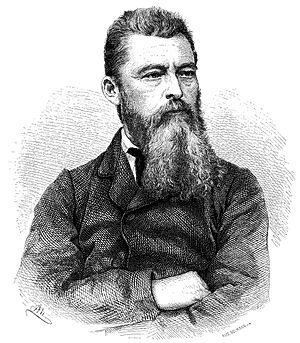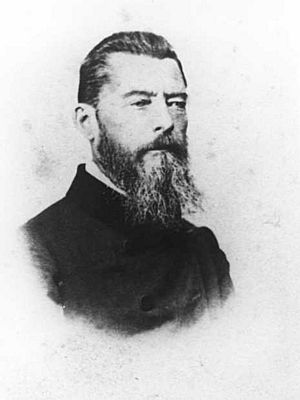Ludwig Feuerbach facts for kids
Quick facts for kids
Ludwig Feuerbach
|
|
|---|---|
 |
|
| Born | 28 July 1804 |
| Died | 13 September 1872 (aged 68) Rechenberg near Nuremberg, German Empire
|
| Education | University of Heidelberg University of Berlin University of Erlangen (Ph.D./Dr. phil. habil., 1828) |
| Era | 19th-century philosophy |
| Region | Western philosophy |
| School | Anthropological materialism Secular humanism Young Hegelians (1820s) |
| Theses |
|
|
Main interests
|
Philosophy of religion |
|
Notable ideas
|
All theological concepts as the reifications of anthropological concepts |
| Signature | |
 |
|
Ludwig Andreas von Feuerbach (German: [ˈluːtvɪç ˈfɔʏɐbax]; 28 July 1804 – 13 September 1872) was an important German thinker. He was an anthropologist and philosopher. He is most famous for his book The Essence of Christianity. This book looked closely at Christian ideas. It greatly influenced many later thinkers. These included famous people like Charles Darwin, Karl Marx, and Sigmund Freud.
Feuerbach was part of a group called the Young Hegelians. He believed in atheism, which means not believing in God. He also supported anthropological materialism. This idea suggests that human nature is the basis for everything. Many of his writings carefully analyzed religion. His ideas helped shape historical materialism. He is often seen as a link between the philosopher Hegel and Karl Marx.
Contents
Life and Career
Ludwig Feuerbach was born into a well-known family. His father, Paul Johann Anselm Ritter von Feuerbach, was a famous lawyer. Ludwig had several brothers who also became successful scholars or scientists. These included Karl Wilhelm Feuerbach, a mathematician. His uncle was the painter Anselm Feuerbach.
His brothers who achieved success were:
- Joseph Anselm Feuerbach (1798–1851), who studied archaeology and languages.
- Eduard August Feuerbach (1803–1843), who studied law.
- Friedrich Heinrich Feuerbach (1806–1880), who studied languages and philosophy.
He also had three sisters:
- Rebekka Magdalena "Helene" Feuerbach von Dobeneck (1808–1891)
- Leonore Feuerbach (1809–1885)
- Elise Feuerbach (1813–1883)
Education and Early Ideas
In 1823, Feuerbach started studying at the University of Heidelberg. He planned to become a Lutheran church minister. However, a professor named Karl Daub got him interested in the philosophy of Hegel. Even though his father disagreed, Feuerbach moved to the University of Berlin in 1824. There, he studied directly with Hegel.
After two years, Feuerbach started to question Hegel's ideas. He joined the Young Hegelians. This group had new, radical ideas based on Hegel's philosophy. They believed that old ways of thinking, especially Christianity, would be replaced. Feuerbach wrote to a friend that he no longer wanted to study theology. He wanted to understand nature and people instead. He finished his studies at the University of Erlangen in 1827. He focused on natural science. He earned his doctorate in 1828. His main paper was about the "Infinitude, Unity, and Universality of Reason."
First Books
Feuerbach's first book, Gedanken über Tod und Unsterblichkeit (1830), was published without his name. In it, he argued against the idea of personal life after death. Instead, he suggested that people become part of nature after they die. These ideas, along with his shy way of speaking, made it hard for him to get a teaching job at a university.
After some difficult years, he published more books. These included a history of modern philosophy and a book about Abelard and Heloise. In 1837, he got married. He then lived in the countryside near Nuremberg. He was supported by his wife's share in a small porcelain factory.
In two other books from this time, Pierre Bayle (1838) and Philosophie und Christentum (1839), he focused on theology. He believed that Christianity had already disappeared from people's minds and lives. He thought it was just an old idea that people held onto.
The Essence of Christianity
Feuerbach's most important book was Das Wesen des Christentums (1841). It was translated into English as The Essence of Christianity by Mary Ann Evans, who later became famous as the writer George Eliot.
Feuerbach's main idea came from Hegel's thinking about creation. Hegel believed that creation is part of the creator, but the creator is still greater. When Feuerbach shared his own ideas with Professor Hegel, Hegel did not agree with them.
In the first part of his book, Feuerbach explained what he called the "true or human essence of religion." He looked at God in different ways. For example, God as a being of understanding, or as a moral being. Feuerbach argued that humans are also conscious beings. He believed humans are even more conscious than God, because humans are the ones who give God the ability to understand. Humans think about many things, and by doing so, they learn about themselves. Feuerbach showed that every aspect of God matches some feature or need of human nature.
Feuerbach concluded that "If man is to find contentment in God, he must find himself in God." This means that God is really just a reflection of human nature. God is like an outward picture of what humans feel inside. Feuerbach called this idea of God a "chimera." He said that the idea of a higher being depends on the idea of kindness. He stated that "a God who is not benevolent, not just, not wise, is no God." He also said that good qualities are not divine just because they are linked to God. Instead, the qualities themselves are divine. This means humans can understand and apply meanings of divinity to religion. It does not mean religion makes humans divine.
Feuerbach explained that people are drawn to religion because God seems to act through humans in many ways. God "is the principle of [man's] salvation, of [man's] good dispositions and actions, consequently [man's] own good principle and nature." He said that people give qualities to their religious idols. Without these qualities, a figure like God would just be an object. Its importance would disappear. There would be no feeling that God exists. So, Feuerbach said, when humans take away all qualities from God, "God is no longer anything more to him than a negative being." Also, because humans are imaginative, they give traits to God, which makes God appealing. God becomes a part of a human through the invention of God. However, humans are also pushed away by God because "God alone is the being who acts of himself."
In the second part of his book, he talked about the "false or religious essence of religion." This is the idea that God exists separately from humans. This leads to mistaken beliefs. For example, the belief in revelation, which he thought harms moral sense. He also believed it "poisons, nay destroys, the divinest feeling in man, the sense of truth." He also criticized beliefs in sacraments like the Lord's Supper. To him, this was a kind of religious materialism. He felt this led to "superstition and immorality."
In 1844, another philosopher named Max Stirner strongly criticized Feuerbach. Stirner's book was called Der Einzige und sein Eigentum (The Ego and His Own). The arguments between their books are an interesting debate.
Later Life
During the German revolutions of 1848–1849, Feuerbach's ideas made him popular with the revolutionary group. However, he never fully joined the political movement. He was not a natural leader. During the time of the Frankfurt Congress, he gave public talks about religion in Heidelberg. After the congress ended, he went back to Bruckberg. He spent his time studying science and writing his book Theogonie (1857).
In 1860, the porcelain factory failed, and he had to leave Bruckberg. He would have faced extreme poverty if friends had not helped him. People also collected money for him. His last book, Gottheit, Freiheit und Unsterblichkeit, came out in 1866. After he had a second stroke in 1870, more money was collected to help him. This was mainly done by the Social Democratic Party of Germany, which he joined that same year. He died on September 13, 1872. He is buried in Johannis-Friedhof Cemetery in Nuremberg, the same place where the artist Albrecht Dürer is buried.
Feuerbach's Philosophical Work
Feuerbach's main idea was a new way to understand religion. He offered a human-centered explanation. Following the ideas of Schleiermacher, Feuerbach thought religion was mostly about feelings. These feelings are very personal and go beyond what we can understand with logic. They show up in different religious beliefs. But beyond feelings, he believed, is imagination. Imagination is what truly creates ideas of "Gods" and sacred things.
See also
 In Spanish: Ludwig Feuerbach para niños
In Spanish: Ludwig Feuerbach para niños
- Theses on Feuerbach by Karl Marx (1845)
- Ludwig Feuerbach and the End of Classical German Philosophy by Friedrich Engels (1886)
- Philosophical anthropology


